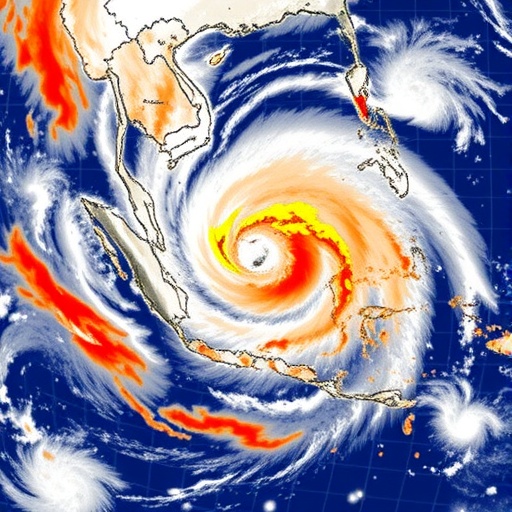In a groundbreaking study published in Commun Earth Environ, researchers have delved into the seasonal variations of tropical cyclone genesis and landfall patterns that significantly affect Southeast Asia, particularly in the context of a warming climate. The research sheds light on the increasingly critical relationship between climate change and tropical cyclones, storms that have been on the rise due to alterations in weather patterns caused by global warming. The insights provided by this study are not only timely but also crucial for policymakers and communities vulnerable to the impacts of these catastrophic weather events.
Tropical cyclones, also known as typhoons in the Northwest Pacific and hurricanes in the Atlantic, are formidable weather systems characterized by powerful winds, heavy rain, and storm surges. Southeast Asia is particularly susceptible to tropical cyclones, a region that has historically faced severe impacts from these storms. Recent warnings from meteorological organizations highlight the frequency and intensity of these cyclonic systems, which are projected to increase under future climate scenarios. The research led by Weaver and colleagues emphasizes the urgent need for a thorough understanding of these patterns.
The researchers utilized a combination of observational data and advanced climate models to investigate how rising global temperatures affect tropical cyclone activity. They noted that monthly variations in cyclone formation and landfall in Southeast Asia are intricately tied to changes in sea surface temperatures, atmospheric conditions, and climatic phenomena such as El Niño. This study aligns with previous observations that indicate shifts in cyclone behavior due to anthropogenic climate change, establishing a clearer connection between high ocean temperatures and increased storm intensity.
One significant finding of the study is the alteration in the timing of cyclone seasons across Southeast Asia. Traditionally, the region experiences distinct cyclone seasons, but data suggests a shift in these patterns, leading to prolonged periods of cyclone activity. This shift could have profound implications for disaster preparedness and resource allocation as communities may remain at risk for extended durations throughout the year. Researchers warn that the implications of these shifts are complex and could lead to increased flooding, landslides, and infrastructure damage if not adequately addressed.
Furthermore, Weaver et al. analyzed historical landfall data to provide an assessment of how cyclone impacts vary across different coastal regions in Southeast Asia. They discovered that certain areas are becoming more vulnerable to landfall events, highlighting the necessity for localized studies that examine the unique geographic and socio-economic factors at play. This is especially crucial for densely populated coastal areas where prepared populations can mitigate damage through timely evacuations and resource planning.
A noteworthy aspect of the study focuses on the socio-economic implications associated with changes in cyclone activity. Tropical cyclones not only pose a direct threat to human life but also disrupt agricultural practices, damage infrastructure, and hinder economic growth. Weaver and colleagues advocate for an integrated approach to disaster risk management that combines scientific research with community engagement, ensuring that local populations are educated and equipped to face these natural disasters.
The role of climate change in intensifying cyclonic activity is underscored by research suggesting an increase in the most severe tropical cyclones, categorized at the highest levels on the Saffir-Simpson scale. These storms bring catastrophic forces that can decimate entire regions, causing billions in damages and leading to long-term recovery challenges. A shift toward a warmer climate could consequently lead to a future where such destructive events become the norm rather than the exception.
In terms of theoretical implications, this study contributes substantially to our understanding of hurricane genesis. It opens a dialogue about the need for revised predictive models that accurately incorporate warming trends. Researchers suggest that a reevaluation of threshold conditions for cyclone formation is necessary, as traditional models may not sufficiently account for the complexities introduced by climate change.
For practical stakeholders—government agencies, urban planners, and emergency responders—this research offers a robust framework for forecasting potential impacts in sensitive areas. Implementation of this knowledge into disaster planning requires immediate action from policymakers. The findings indicate an urgent call to develop more resilient infrastructure and adapt existing urban environments to better withstand the anticipated changes in cyclone behavior.
In conclusion, the research conducted by Weaver, Garner, Samanta, et al. represents a pivotal moment in the discourse surrounding tropical cyclones in Southeast Asia. By examining the interplay between seasonal variations, cyclone formation, and climate change, the study emphasizes the necessity of proactive measures in mitigating the impacts of these severe weather events. As climate projections continue to evolve, ongoing research will be essential in maintaining our understanding of tropical cyclone dynamics and developing effective strategies to protect vulnerable communities across Southeast Asia.
The increasing frequency and severity of tropical cyclones demand a collective response, with scientific inquiry leading the way. As we interpret the threats posed by climate change, it becomes imperative that our preparations are informed by solid data and a profound understanding of natural phenomena, positioning us to navigate an uncertain climate future.
Subject of Research: Seasonal variations of tropical cyclone genesis and landfall patterns in Southeast Asia in a warmer climate.
Article Title: Seasonal variations of tropical cyclone genesis and landfall patterns impacting Southeast Asia in a warmer climate.
Article References:
Weaver, M.M., Garner, A.J., Samanta, D. et al. Seasonal variations of tropical cyclone genesis and landfall patterns impacting Southeast Asia in a warmer climate.
Commun Earth Environ 6, 866 (2025). https://doi.org/10.1038/s43247-025-02566-w
Image Credits: AI Generated
DOI: https://doi.org/10.1038/s43247-025-02566-w
Keywords: Climate Change, Tropical Cyclones, Southeast Asia, Cyclone Genesis, Weather Patterns, Environmental Science, Disaster Management.




